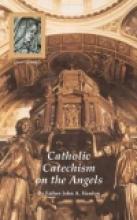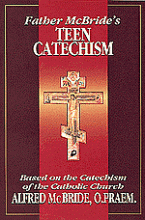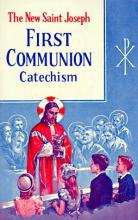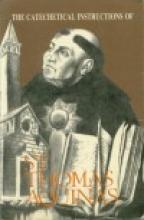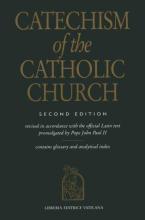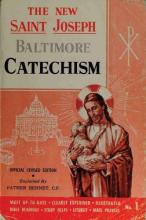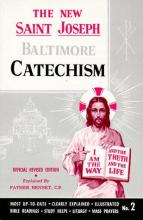Catechisms
Catholic Catechism on the Angels
In today's culture, angels are represented on everything from popular television programs to needlecraft projects, but they are rarely portrayed accurately. This little powerhouse of a book sets the record straight on Catholic teaching regarding our "holy helpers". Thorough but concise, it is written for upper high-school students and adults.
The book is organized into three sections that take the form of a brief essay followed by a question-and-answer catechism clarifying each point made. Father Hardon begins with a study of the angels, providing an explanation of angelic terms and definitions commonly used in reference to angels; adversaries, which are those individuals or systems which deny the doctrines about angels; and doctrinal value, which refers to the need for a believing Catholic to accept what is taught by the Church. He continues with the Catholic doctrines on the existence of angels from three different directions: ecclesiastical authority, sacred scripture, and theological reasoning. Finally, Father Hardon concludes with the proofs that angels are pure spirits from ecclesiastical authority, sacred scripture and tradition, and patristic evidence.
Imprimatur and Nihil Obstat
Father McBride's Teen Catechism
Teen Catechism is a nice entry point into the Catechism of the Catholic Church. In spite of its name, Teen Catechism could be used by an adult convert or any person who wants a solid introduction to or review of our Catholic faith. It follows the topic sequence of the Catechism, covering the Creed, the Sacraments, Morality, and Prayer in its 36 chapters.
Each chapter begins with a passage quoted from another source which is selected as a lead-in to the chapter's topic. The purpose is to raise questions in the reader's mind, or make him aware that there is a question involved. This is followed by a "Some Say" section which is a wrong or incomplete version of the answer. Then there is a "The Catechism Teaches" section which contains quotes from the Catechism on that topic, and "We Catholics Believe" which translates the CCC quotes into everyday language. The "Reflection" is a quote from Scripture or a saint's writings which allows one to meditate further on the topic. Each chapter concludes with "In my Life" a series of open-ended questions which lead the reader to ponder how to apply the stated truths of the chapter to his life. Finally, there is a Prayer and a glossary of theological terms used in the chapter.
The layout is very clear and easy to follow. A variety of fonts are used to distinguish the different parts of the chapter from each other. Brief Scripture verses introduce and conclude the meditations. There is at least one black and white illustration per chapter, either a photograph or a sketch related to the topic. The strategy within the chapters is somewhat similar to St Thomas Aquinas's layout in the Summa Theologicae — a question, some objections, then a reply to the objections. This approach is well suited to the world we live in today, where we often hear a multiplicity of different opinions on a topic, and it is difficult to sort out which is closest to the traditional teachings of the Church.
The book could easily be used in a discussion group, or even as topics for personal devotions. It would be easy to plan "extensions" or further study on a given topic, either by looking into what the Catholic Catechism says in full, or by doing further research on the saints and other people mentioned within the book.
So much of the time, the word "teen" is associated with trendy, lightweight resources, but this book is quite the opposite. It is a solid and thoughtful introduction to the basics of our Catholic faith. One caution for younger readers: in the sections on the 6th and 9th Commandments, the opening stories are of St Maria Goretti, and the story of Susannah and the wicked judges. While the stories are not unnecessarily graphic, they do cover the topic of rape and violence, and may need to be discussed by parents with their younger teenagers.
Saint Joseph First Communion Catechism
This beautifully illustrated (in full-color) gem is designed to prepare a child for First Communion and would be appropriate for Kindergarten through second grade. The text follows the Baltimore Catechism, but also includes basic prayers, parts of the Mass and Holy Days of Obligation. In a few places, the explanations given to expand upon the Baltimore Catechism are not as well-written as I'd like them to be, but for the most part they are quite good. For some reason, the text has taken some of the Catechism questions out of order, so that the child learns about sin and its consequences before studying about Our Lord coming to earth to save us. I prefer the original order (which can be done by following the questions in numerical order) so that young children learn about God's love for us before going too deep into the evils of sin and the devil. Many homeschoolers use this as a supplement to other texts (such as the Faith and Life series - partly because the wording of the questions in this text is more succint than the wording in the Faith and Life series) for the purpose of memorizing the Catechism questions and enjoying the pictures.
The Catechetical Instructions of Saint Thomas Aquinas
Saint Thomas provides beautiful explanations of the Apostles' Creed, the Ten Commandments, the Sacraments, the Lord's Prayer and the Hail Mary.
Sample passages:
"From all this then is seen the effect of the passion of Christ as a remedy for sin. But no less does it profit us as an example. St. Augustine says that the passion of christ can bring about a complete reformation of our lives. Whoever wishes to live perfectly need do nothing other than despise what Christ despised on the Cross, and desire what Christ desired. There is no virtue that did not have its example on the Cross."
"The plenitude of grace in Mary was such that its effects overflow upon all men. It is a great thing in a Saint when he has grace to bring about the salvation of many, but it is exceedingly wonderful when grace is of such abundance as to be sufficient for the salvation of all men in the world, and this is true of Christ and of the Blessed Virgin. Thus, 'a thousand bucklers,' that is, remedies against dangers, 'hang therefrom.' Likewise, in every work of virtue one can have her as one's helper. Of her it was spoken: ' In me is all grace of the way and of the truth, in me is all hope of life and of virtue.' Therefore, Mary is full of grace, exceeding the Angels in this fullness and very fittingly is she called 'Mary' which means 'in herself enlightened': 'The Lord will fill thy soul with brightness.' And she will illumine others throughout the world, for which reason she is compared to the sun and the moon."
Written in the 1200s, this English edition has a 1939 Imprimatur.
Update from the webmaster, March 2024: This book is available from a variety of sources because its text is in the public domain. The Click here for the full text of the Catechetical Instructions, at the Internet Archive.
The Catechism of the Catholic Church: Second Edition
This beautiful new Catechism is truly a gift and a treasure in an era when "new" so often means "bad." Although I have not yet read every word of it (it's quite a big book!) I have had the pleasure of leading Catechism study groups for mothers and found much success in using this text to help some who were previously very lukewarm in their faith to better understand not only what the Catholic Church really teaches, but why these teachings make sense - yes, even in our modern world!
The Catechism is divided into four main sections. The First, the Profession of Faith, covers the basic beliefs and dogmas of the Church - based upon the Creed. Part Two, "The Celebration of the Christian Mystery", discusses liturgy and the Sacraments. Part Three, "Life in Christ", covers moral life - particularly in light of the Beatitudes and the Ten Commandments. Part Four is on Christian Prayer.
The text is both difficult and joyful to read. It is difficult (in some places) because of the unfamiliar vocabulary - catechesis, pedagogy, asceticism, fecundity - these are not part of our every day vocabulary (although many should be learned by high schoolers). Even so, the new edition has an in-depth glossary in the back and these more unfamiliar words come up once every few paragraphs rather than every other sentence. It is joyful to read because it is so rich, so beautiful, so true. Throughout the text, the reader is referred to Sacred Scripture, Church documents and the writings of the Saints. An additional volume The Companion to the Catechism of the Catholic Church, published by Ignatius Press, provides the text from all of the footnotes for easy reference and further study.
A few sample passages:
(407) "The doctrine of original sin, closely connected with that of redemption by Christ, provides lucid discernment of man's situation and activity in the world. By our first parents' sin, the devil has acquired a certain domination over man, even though man remains free. Original sin entails 'captivity under the power of him who thenceforth had the power of death, that is, the devil.' Ignorance of the fact that man has a wounded nature inclined to evil gives rise to serious errors in the areas of education, politics, social action and morals."
(1395) "By the same charity that it enkindles in us, the Eucharist preserves us from future mortal sins. The more we share the life of Christ and progress in his friendship, the more difficult it is to break away from him by mortal sin. The Eucharist is not ordered to the forgiveness of mortal sins - that is proper to the sacrament of Reconciliation. The Eucharist is properly the sacrament of those who are in full communion with the Church."
(2521) "Purity requires modesty, an integral part of temperance. Modesty protects the intimate center of the person. It means refusing to unveil what should remain hidden. It is ordered to chastity to whose sensitivity it bears witness. It guides how one looks at others and behaves toward them in conformity with the dignity of persons and their solidarity."
(2712) "Contemplative prayer is the prayer of the child of God, of the forgiven sinner who agrees to welcome the love by which he is loved and who wants to respond to it by loving even more. But he knows that the love he is returning is poured out by the Spirit in his heart, for everything is grace from God. Contemplative prayer is the poor and humble surrender to the loving will of the Father in ever deeper union with his beloved Son."
Many beautiful writings of the Saints are included (in addition to those which are merely footnoted), such as this passage from St. Ignatius of Loyola (taken from the Spiritual Exercises):
"Every good Christian ought to be more ready to give a favorable interpretation to another's statement than to condemn it. But if he cannot do so, let him ask how the other understands it. And if the latter understands it badly, let the former correct him with love. If that does not suffice, let the Christian try all suitable ways to bring the other to a correct interpretation so that he may be saved."
This book belongs in every Catholic home. It should be read over, and prayed over, and cried over, and smiled over often.
The New Saint Joseph Baltimore Catechism No.1
Though very inexpensive, the New Saint Joseph Baltimore Catechisms with explanations written by Father Kelley are worth their weight in gold. They are based on the Baltimore Catechism which was first approved by the Archbishop of Baltimore, James Cardinal Gibbons in 1885. The New Saint Joseph version goes beyond the simple question-and-answer format of the original catechism, it incorporates Holy Scripture with each lesson and includes discussion questions, a fill-in-the-blank section, and suggested Bible readings at the end of each lesson. The pictures themselves are a great teaching tool, as they illustrate spiritual truths.
Memorizing the questions and answers of the catechism provides the opportunity to build a religious foundation. This basic Catholic doctrinal foundation gives children the tools necessary to defend their faith when they are old enough to apply reason and logic, much like memorizing the alphabet before learning to read and analyze literature.
In addition to memorization of the question and answers, I copy the accompanying Scripture onto a 3 by 5 index card. Then the children and I memorize the Scripture verse and discuss how it applies to the week's lesson. I am careful to emphasize the Scripture as a part of a whole picture rather than putting too much emphasis on individual verses. We review the Q&A and Scripture each day for a week, before moving on to the next lesson. Book no. 1 has the Baltimore questions and answers divided into three parts: The Creed, The Commandments, and The Sacraments and Prayer. Its recommended use is for grades three through five.
This book is available from nearly all Catholic homeschool providers, including those listed below.
The New St. Joseph Baltimore Catechism No. 2
Book no. 2 has the same division and order as book no. 1, reviewed here, but the lessons are more in depth for the older student, taking a spiral approach. Its recommended use is for grades six through eight.
This book is available from nearly all Catholic homeschool providers.

